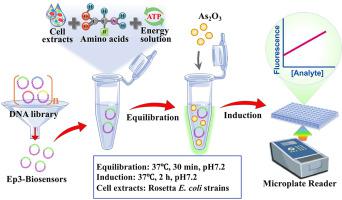Ecotoxicology and Environmental Safety ( IF 6.8 ) Pub Date : 2020-09-08 , DOI: 10.1016/j.ecoenv.2020.111273 Xuanyu Wang 1 , Kaili Zhu 1 , Dongdong Chen 2 , Juan Wang 1 , Xiaofei Wang 3 , An Xu 1 , Lijun Wu 4 , Luzhi Li 3 , Shaopeng Chen 5

|
Toxic pollutant (TP) detection in situ using analytical instruments or whole-cell biosensors is inconvenient. Designing and developing genetically coded biosensors in vitro for real-world TP detection is a promising alternative. However, because the bioactivity and stability of some key biomolecules are weakened in vitro, the response and regulation of reporter protein become difficult. Here, we established a genetically encoded biosensor in vitro with an arsenical resistance operon repressor (ArsR) and GFP reporter gene. Given that the wildtype ArsR did not respond to arsenic and activate GFP expression in vitro, we found, after screening, an evolved ArsR mutant ep3 could respond to arsenic and exhibited an approximately 3.4-fold fluorescence increase. Arsenic induced expression of both wildtype ArsR and ep3 mutant in vitro, however, only ep3 mutant regulated the expression of reporter gene. Furthermore, the effects of cell extracts, temperature, pH, incubation, and equilibrium time were investigated, and the equilibration of reaction mixtures for 30 min at 37 °C was found to be essential for in vitro arsenic detection prior to treatment with arsenic. Based on our data, we established a standard procedure for arsenic detection in vitro. Our results will facilitate the practical application of genetically encoded biosensors in TP monitoring.
中文翻译:

使用遗传编码的生物传感器在体外监测砷:进化调控基因的作用。
使用分析仪器或全细胞生物传感器原位检测有毒污染物(TP)并不方便。体外设计和开发用于实际TP检测的基因编码生物传感器是一种有前途的选择。然而,由于一些关键生物分子的生物活性和稳定性在体外被削弱,因此报道蛋白的反应和调节变得困难。在这里,我们建立了具有砷抗性操纵子阻遏物(ArsR)和GFP报告基因的体外遗传编码生物传感器。鉴于野生型ArsR在体外不响应砷并激活GFP表达,我们发现,筛选后,进化出的ArsR突变体ep3可能对砷有反应,并显示出约3.4倍的荧光增加。砷在体外诱导野生型ArsR和ep3突变体的表达,但是,只有ep3突变体调节报告基因的表达。此外,研究了细胞提取物,温度,pH,温育和平衡时间的影响,发现在37°C下反应混合物30分钟的平衡对于用砷处理之前的体外砷检测至关重要。根据我们的数据,我们建立了体外砷检测的标准程序。我们的结果将促进遗传编码生物传感器在TP监测中的实际应用。



























 京公网安备 11010802027423号
京公网安备 11010802027423号